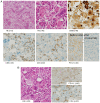Application of PD-L1 blockade in refractory histiocytic sarcoma: A case report
- PMID: 35949894
- PMCID: PMC9353867
- DOI: 10.3892/mco.2022.2569
Application of PD-L1 blockade in refractory histiocytic sarcoma: A case report
Abstract
Histiocytic sarcoma (HS) is a rare hematological malignancy, which exhibits morphological and immunophenotypic features of histiocytes. A standard therapy for HS has not yet been established due to its rareness; therefore, disease control is not always possible. A multimodal treatment strategy has been suggested for HS. The present study reported on a case of a 43-year-old female patient who complained of left femoral pain, which was caused by left femoral bone mass. A biopsy of their left femoral bone tumor revealed that the patient had HS. Their sarcoma was localized in the femoral bone and was not considered to be curable, due to local infiltration of the bone tumor beyond the periosteum. The patient then underwent two types of HS-specific chemotherapy; however, both regimens were ineffective. As a result, they underwent radiation therapy at the sites of progressive disease. Because the HS cells of the patient expressed PD-L1, they were treated with nivolumab (240 mg/body, biweekly) for residual diseases in the right occipital bone, multiple lung nodules, intrapelvic right lymph node and primary site. Nivolumab treatment resulted in a complete response at all sites, with the exception of the primary site, which was confirmed by 18F-fluorodeoxyglucose-positron emission tomography/computed tomography. The patient received additional nivolumab treatment as consolidation therapy for 1 year. In addition, residual disease of the femoral head was completely resected. The surgically resected refractory tumor revealed the tumor cells no longer pathologically expressed PD-L1 . In conclusion, for refractory and recurrent HS in which surgical resection is not appropriate, treatment with immune-checkpoint inhibitors, such as nivolumab, may be considered an optional but promising immunotherapy if the tumor histologically expresses PD-L1. The present study detected one of the refractory mechanisms of ICI treatment.
Keywords: 18F-FDG-PET; PD-L1; histiocytic sarcoma; immune-checkpoint inhibitor; nivolumab; resistance mechanism.
Copyright: © Imataki et al.
Conflict of interest statement
The authors declare that they have no competing interests.
Figures



Similar articles
-
Primary pulmonary histiocytic sarcoma with high PD-L1 expression benefited from immunotherapy: A case report and bioinformatic analysis.Clin Respir J. 2024 Mar;18(3):e13741. doi: 10.1111/crj.13741. Clin Respir J. 2024. PMID: 38450981 Free PMC article.
-
Long-Term Remission with Novel Combined Immune-Targeted Treatment for Histiocytic Sarcoma Accompanied by Follicular Lymphoma: Case Report and Literature Review.Int J Mol Sci. 2024 Jul 2;25(13):7293. doi: 10.3390/ijms25137293. Int J Mol Sci. 2024. PMID: 39000399 Free PMC article. Review.
-
Favorable outcome of a histiocytic sarcoma patient treated with immune checkpoint inhibitor: a case report.Ann Med Surg (Lond). 2023 Nov 1;85(12):6274-6278. doi: 10.1097/MS9.0000000000001446. eCollection 2023 Dec. Ann Med Surg (Lond). 2023. PMID: 38098600 Free PMC article.
-
FDG-PET in the evaluation of response to nivolumab in recurrent non-small-cell lung cancer.World J Surg Oncol. 2016 Sep 5;14(1):238. doi: 10.1186/s12957-016-0998-y. World J Surg Oncol. 2016. PMID: 27595749 Free PMC article.
-
Primary histiocytic sarcoma of the central nervous system: a case report with platelet derived growth factor receptor mutation and PD-L1/PD-L2 expression and literature review.Radiat Oncol. 2018 Sep 5;13(1):167. doi: 10.1186/s13014-018-1115-x. Radiat Oncol. 2018. PMID: 30185195 Free PMC article. Review.
Cited by
-
BRAF V600E mutation and high expression of PD-L1 in Rosai-Dorfman disease: case report and review of the literature.J Hematop. 2024 Dec;17(4):183-189. doi: 10.1007/s12308-024-00611-9. Epub 2024 Nov 27. J Hematop. 2024. PMID: 39592527 Free PMC article. Review.
-
Uncommon but intriguing: A pediatric primary histiocytic sarcoma case-Clinical insights and literature review.Radiol Case Rep. 2025 May 15;20(8):3748-3754. doi: 10.1016/j.radcr.2025.04.063. eCollection 2025 Aug. Radiol Case Rep. 2025. PMID: 40486162 Free PMC article.
-
Primary pulmonary histiocytic sarcoma with high PD-L1 expression benefited from immunotherapy: A case report and bioinformatic analysis.Clin Respir J. 2024 Mar;18(3):e13741. doi: 10.1111/crj.13741. Clin Respir J. 2024. PMID: 38450981 Free PMC article.
-
Long-Term Remission with Novel Combined Immune-Targeted Treatment for Histiocytic Sarcoma Accompanied by Follicular Lymphoma: Case Report and Literature Review.Int J Mol Sci. 2024 Jul 2;25(13):7293. doi: 10.3390/ijms25137293. Int J Mol Sci. 2024. PMID: 39000399 Free PMC article. Review.
-
Favorable outcome of a histiocytic sarcoma patient treated with immune checkpoint inhibitor: a case report.Ann Med Surg (Lond). 2023 Nov 1;85(12):6274-6278. doi: 10.1097/MS9.0000000000001446. eCollection 2023 Dec. Ann Med Surg (Lond). 2023. PMID: 38098600 Free PMC article.
References
-
- Swerdlow SH, Campo E, Harris NL, Jaffe ES, Pileri SA, Stein H, Thiele J. WHO classification of tumours of haematopoietic and lymphoid tissues. Revised Fourth Edition World Health Organization classification of tumours. IARC, Lyon, 2017.
-
- Emile JF, Abla O, Fraitag S, Horne A, Haroche J, Donadieu J, Requena-Caballero L, Jordan MB, Abdel-Wahab O, Allen CE, et al. Revised classification of histiocytoses and neoplasms of the macrophage-dendritic cell lineages. Blood. 2016;127:2672–2681. doi: 10.1182/blood-2016-01-690636. - DOI - PMC - PubMed
Publication types
LinkOut - more resources
Full Text Sources
Research Materials
